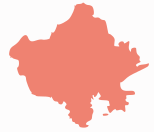This article needs additional citations for verification .(December 2021) |
Tonk district | |
|---|---|
Top: Sudarshanoday Teerth Kshetra, Anwa Bottom: Bisaldeo temple | |
 Location of Tonk district in Rajasthan | |
| Country | |
| State | Rajasthan |
| Division | Ajmer |
| Headquarters | Tonk |
| Government | |
| • Zila Pramukh | Saroj Bansal |
| Area | |
• Total | 7,194 km2 (2,778 sq mi) |
| Population (2011) [1] | |
• Total | 1,421,326 |
| • Density | 200/km2 (510/sq mi) |
| Time zone | UTC+05:30 (IST) |
| Website | tonk |
Tonk district is a district of the state of Rajasthan in western India. The city of Tonk is the administrative headquarters of the district. The district is bounded on the north by Jaipur district, on the east by Sawai Madhopur district, on the southeast by Kota district, on the south by Bundi district, on the southwest by Bhilwara district, and on the west by Ajmer district.


